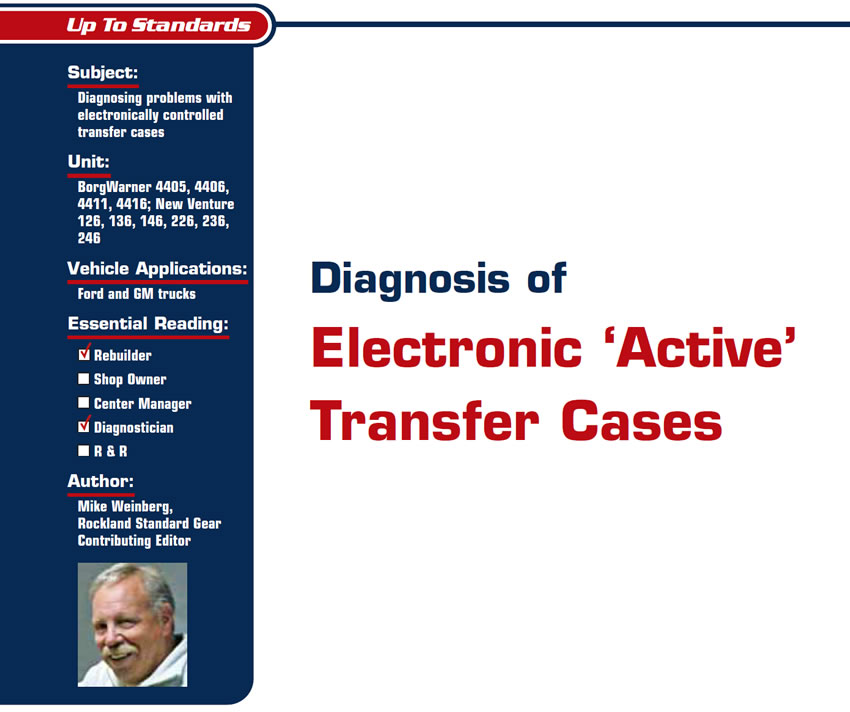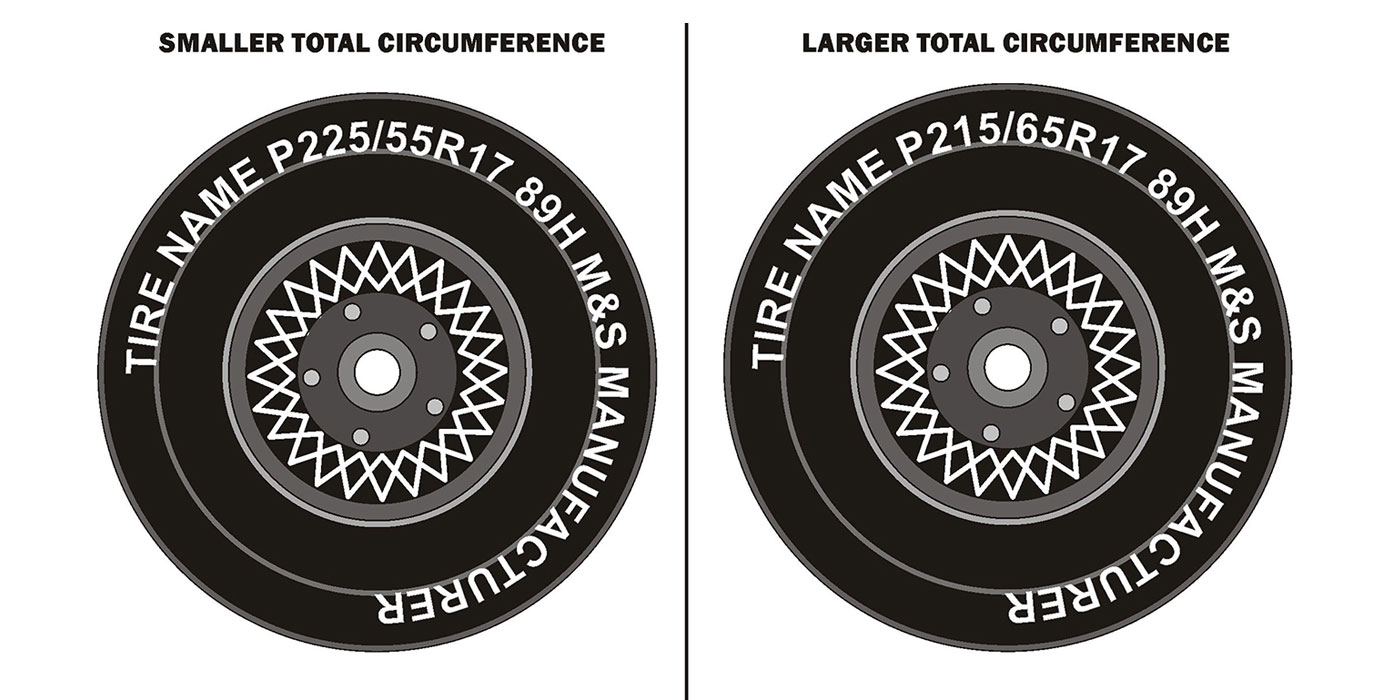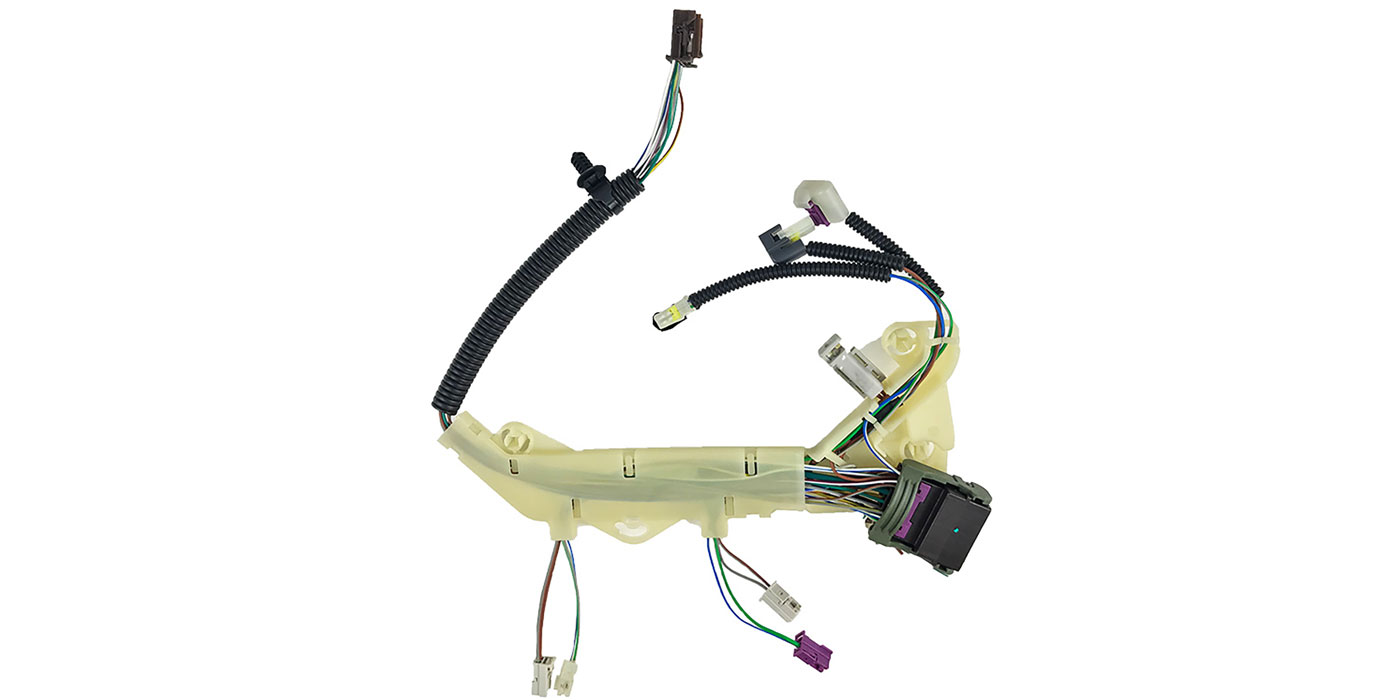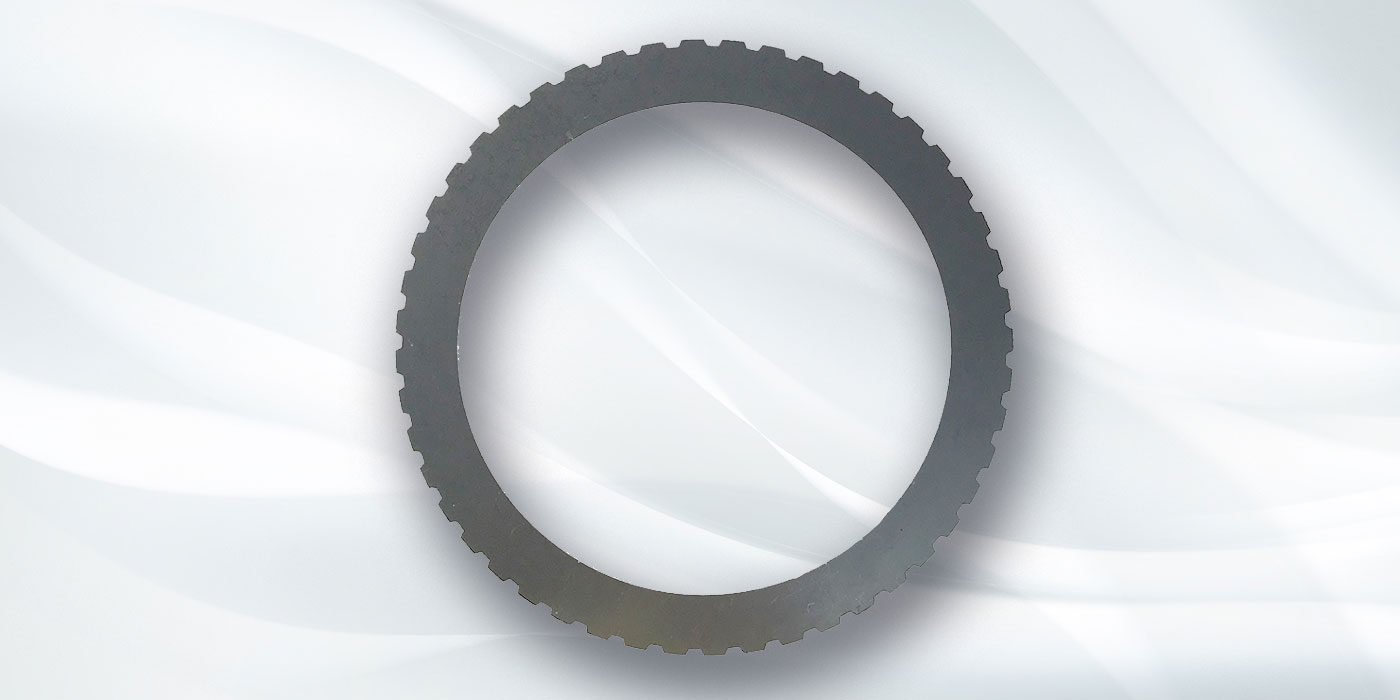
Up to Standards
- Subject: Diagnosing problems with electronically controlled transfer cases
- Units: BorgWarner 4405, 4406, 4411, 4416; New Venture 126, 136, 146, 226, 236, 246
- Vehicle Applications: Ford and GM trucks
- Essential Reading: Rebuilder, Diagnostician
- Author: Mike Weinberg, Rockland Standard Gear, Contributing Editor
This is the fourth article in a series devoted to diagnosis of manual transmissions and transfer cases. Electronic “active” transfer cases cause 70% of the tech calls we receive.
An active transfer case is an electrically controlled power divider that has the capability of transferring power to the drive axle that needs it without any input from the driver. Speed sensors mounted on the front and rear output shafts inform the computer of wheel speed for each axle. If the speed between the axles is not the same, the computer interprets this as wheel slip and engages an internal clutch pack to send power to the other axle. When the wheel speeds again correspond, the clutch will return to minimum duty cycle.

Although this process is simple in theory, it becomes very complex because of other systems in the vehicle. Antilock brakes, stability control, traction control, transmission controls and engine-management systems are all connected to the transfer-case electronics, so diagnosis and testing must cover all these systems. The diagnostic repair section of the manual on any of these transfer cases can run to more than 100 pages, and there is not enough space in a year’s magazines to cover it all.
The most-common electronic active transfer cases you will see are the BorgWarner 4405, 4406, 4411 and 4416, and the New Venture 126, 136, 146, 226, 236 and 246. This article describes a step-by-step approach to shortcut the diagnostic process and some quick paths to checking out the most-common problems. As in any diagnostic approach to a problem, you need to follow each step in order every time. If you jump around or skip steps you will only wind up wasting time unless you are incredibly lucky. Follow the yellow brick road and you will get to be a wizard.
To start, you will need access to the factory wiring and diagnostic trees and code charts. Some of these units can throw off almost 100 trouble codes. You will need a scan tool that can access all the vehicle’s computers. There will be different sets of codes for each computer, and if you cannot access the transfer-case computer or other electronic control modules you will be lost. A good volt/ohmmeter (preferably with a scope feature) also is a must.
The last thing you need is common sense and a strong will to RESIST removing the transfer case from the vehicle before performing a complete diagnostic routine. The vehicle is your dyno, and if there are multiple systems outside of the transfer case that can affect it, pulling out the transfer case before you have discovered where the cause of the problem is means you will be looking at only the effects and collateral damage instead of solving the problem.
Step 1
Measure all four tires and check tire pressures. You will need a tape measure or a stagger gauge to measure the tire circumference on each wheel. What the sidewalls say is meaningless; you must make sure all pressures are the same and each tire circumference is within 1/4 inch of the others. In the repair manuals GM says that propshaft speeds must be within 15 rpm of each other. This translates into 1/16 inch on the tires. The Ford manuals say tires must be within 0.006 inch. My experience is that 1/4 inch will work in real-world situations.
If you are not going to do this before working on a transfer case, save your time and don’t read further. You can install 50 new units in a vehicle with mismatched tires and none of them will function correctly. If the tires do not match up to the 1/4-inch spec, get the customer involved and make sure he authorizes the tire replacement. Measure the new tires, as you will see many that do not match up brand new. Remember that the computer is measuring the shaft speeds of the front and rear output shafts. A tire-size difference will fool the computer into sensing that a wheel is slipping and will create all kinds of misdirection for you.
Step 2
Check the fluid for correct fill level and quality. Make sure there is enough of the correct fluid in the unit, and observe color and quality. If the fluid is burnt, contaminated with debris or has an evil odor, accept this as part of your diagnosis. The burnt fluid can be either a cause of your problem or an effect of external problems causing the clutch pack to overwork. Again, resist all the urges to pull out the unit until you know for sure that every external system is working correctly. Once you correct all external inputs to the system, you always have time to repair the unit if required. Installing a repaired or reman unit will just cause damage to the new unit and result in a huge waste of time if all systems are not good to go.
Step 3
Check battery voltage to make sure there is sufficient energy available to run all these computers, and scan the vehicle for codes. Make sure that your scan-tool program can access all the computers in the vehicle. You cannot do this if you can read only engine-management codes. There will be B codes, C codes, P codes and U codes that must be reviewed. Once you have written down the codes present, disconnect the negative battery lead for 30 seconds, reconnect, and check codes again to make sure they are all gone. Now test-drive the vehicle and scan for codes again to see which if any have returned and are hard codes. On some vehicle systems you may have to take a long-enough road test for any adaptive logic in the computers to relearn the vehicle. Any codes that have returned must be fixed now.
Step 4
Disconnect the output-shaft-speed sensors and read them directly with a scan tool. They must read equally at a given road speed. A scope feature on your scan tool or ohmmeter is quite helpful here, as you will see speed sensors with signals that appear good on the scan tool but will show up as noise under higher speeds. If the speed sensors are good, reconnect them and back-probe the computer terminals on the speed-sensor circuits to verify that the wiring has good integrity and that the signal is actually reaching the computer.
“Why do this if there are no codes present?” you may be asking. Because many times we find that speed-sensor problems will not set a code, especially if they are sending signals to the computer but the signals do not match each other precisely. You now know that the computer is getting the correct information.
Step 5
With all codes removed and any electronic problems solved or repaired, and the transfer case functioning properly, you are finished. If you clear the codes and resolve any electronic problems but the transfer case does not work properly, we now know we are dealing with a mechanical problem. Now review the complaint. Does the transfer case chatter on turns? Disconnect the transfer-case harness and drive again. Does it still chatter? Check for a bad rear or bad posi differential, or on Ford units determine whether the unit is locked in failsafe mode. If the chatter is gone, you have an electronic problem such as a failed transfer-case control module that will throw no codes.

Common problems with the BorgWarner 4405, 4406, 4411 and 4416 transfer cases in Ford vehicles:
- No response to scan tool on 2002 Ford Explorers – failed 4WD control module
- Erratic rear output-shaft speed-sensor reading with new speed sensor, 1996-2004 Ford models – transfer-case rear output-shaft bearing has worn out the bore in the case, allowing too much endplay. Replace the rear transfer-case half.
- Binding on tight turns at low speed, such as on a parking lot, 1995-99 Explorers – bad speed sensors, or shorted or open short harness from under driver’s seat to transfer case. Replace harness. 2000-and-up models, bad speed sensors or bad connector at the transfer case. Check for corrosion, loose or bent pins; fix or replace as necessary.
- Bump, bump, bump on hard acceleration, no codes present – replace transfer-case fluid with Chatter Free, p/n RSG-CF.
- 4405-4411 neutralizes on throttle lift; grinding noise; nose leaves on acceleration – replace transfer-case assembly with unit that has corrected internal geometry to prevent side loading of shift fork and rail.
- 4405-4411 in normal driving produces banging noise that sounds like a broken spider gear – same as above: Replace transfer-case assembly with corrected model.
New Venture Gear
- 126-226 – binding on turns. Replace fluid with Chatter Free, p/n RSG-CF. Enter diagnostic routine and observe clutch-pack application rates and percentage of duty cycle. If front thrust bearing has failed, clutch will over-travel, allowing encoder motor to go out of range.
- 136-146 – binding on turns. Replace fluid with Chatter Free, p/n RSG-CF. Do not use aftermarket actuator motors that use a bushing in the case for the apply shaft. The OE unit uses a needle bearing in the case for the apply shaft. The clutch has a 300-pound application force and will lock the aftermarket motor into the bushing, causing permanent clutch engagement.
- 236-246 – no auto 4WD; will have 4W high or low. Bad front or rear output-shaft speed sensors or wiring. Will not show a code. Read speed sensors with ohmmeter or scope. If sensors match, read signal at the control module to check circuit integrity.
- 236-246 – low or no fluid. Check rear case for leak at hole worn through by oil-pump locating tabs. Replace case.
- 236-246 – excessive endplay at rear output shaft. Rear output-shaft bearing has worn out bearing bore. Replace case.
- 236-246 – Do not use aftermarket actuator motors that use bushing in case; same as 136-146 previously mentioned.
Note: In 1998-2002 236-246 transfer cases, the front driveshaft is always engaged, and the clutch pack has 100 pounds of preload. In later models the front driveshaft will turn by hand with slight resistance.
Everyone looks for the “quick fix,” but in the real world there are no shortcuts. Working from the factory schematics and diagnostic trees will help you solve the electrical issues. Knowing how the unit works and is related to other vehicle systems will keep you from chasing your tail. The routine we listed here will help you to have a consistent outcome every time without wasted effort. The tips mentioned are problems that show up on the tech line constantly. I wish all of you a happy holiday season and a healthy, prosperous New Year.














